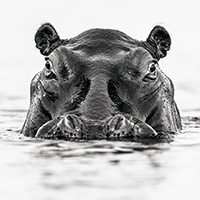Video: Can high-key, high-contrast black and white processing save flat wildlife photos?
posted Thursday, May 5, 2022 at 12:30 PM EDT

Wildlife photographer Steve Perry has been shooting more high-key and high-contrast black and white wildlife photos in the last few years. He finds that they're a good way to deal with otherwise challenging conditions.
Perry employs high-key black and white photos when the natural light and color are flat or bland. It's also a good approach when light is harsh or when subjects are backlit. If you properly expose a backlit animal, the sky, which may otherwise be blue or gray, can be bright white, which can be great for high-key black and white images. This high-key monochromatic approach is also an option when the conditions are foggy or misty, which can sap a scene of color.
Perry recommends looking for plain, preferably bright backgrounds when looking for opportunities to use a high-key, high-contrast black and white processing technique. You want to avoid dark, busy backgrounds. 'The smoother and brighter the background, the better this technique works,' says Perry in the video below.
When you're in the field, and you think you may want to convert your image to a high-key black and white photo later, you must make sure that your subject is properly exposed, even if that means the background gets blown out. It's okay if the background is super bright and has no detail. Your image may look really bad on the back of your camera, but don't worry because the photo could look amazing when you're done with post-processing. Perry also recommends keeping your ISO as low as possible, as his editing technique will push his raw image files very hard, which can increase noise. If you start with a noisy image, it may be way too noisy.
Much like the field capture for high-key, high-contrast black and white wildlife photos isn't very complicated, neither is the post-processing. You'll often add contrast, texture and clarity while ensuring a good tonal range from dark gray or black to light gray or white. While an image may look flat in color, it may be dynamic and interesting in black and white. In the video above, Perry runs through various wildlife images and shows off different post-processing and black and white conversion techniques.
The next time you are dealt a tough hand when photographing wildlife, either with flat light or bad color, about how an image could look in black and white while in the field. Expose for your subject and give some of Perry's techniques above a try in your favorite photo editing application. You may be able to turn some shots you didn't like into real winners.
To see more from Steve Perry, visit his YouTube channel and website. You can also follow him on Instagram.
(Via Steve Perry)